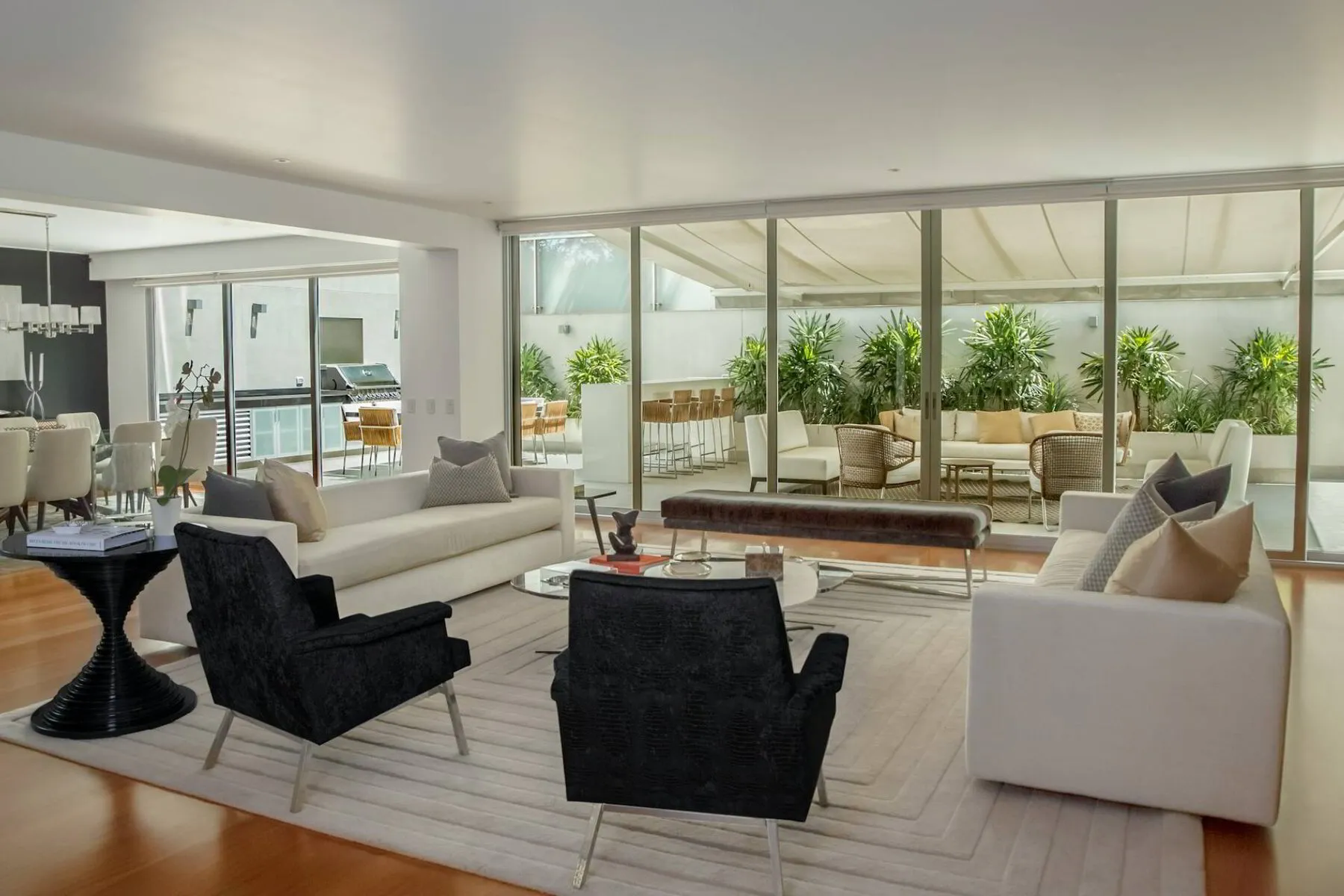Biophilic interior design is the practice of connecting indoor spaces with nature to enhance health, well-being, and environmental sustainability. Biophilic design creates a serene and rejuvenating living environment that positively impacts human health by incorporating natural elements like plants, natural light, and organic materials.
The benefits include reduced stress, improved air quality, and a stronger connection to the natural world. In this article, you'll discover practical tips and creative ideas for integrating biophilic design into your home, transforming your living space into a harmonious sanctuary that nurtures both body and mind.
Key Takeaways
- Integrate Natural Elements: Incorporate natural materials like wood and stone to bring a sense of the outdoors inside your home.
- Maximize Natural Light: Use large windows, skylights, and reflective surfaces to increase natural light and enhance your connection with nature.
- Add Indoor Plants: Introduce a variety of indoor plants to improve air quality and create a calming, natural ambiance.
- Use Earthy Colors: Choose a color palette inspired by nature, including greens, browns, and blues, to create a soothing and grounded environment.
- Incorporate Water Features: Include water elements like fountains or aquariums to add a tranquil, natural touch to your interior design
What is Biophilic Interior Design?
Biophilic interior design integrates natural elements into indoor spaces to create a connection with nature. Interior designers play a crucial role in implementing biophilic design, incorporating nature-inspired aspects, and ensuring harmony between built and organic elements within spaces.
Core principles include using natural materials like wood and stone, maximizing natural light, and incorporating indoor plants. Unlike minimalist or industrial styles, which focus on sleek lines and artificial materials, biophilic design emphasizes organic textures and greenery.
For example, a biophilic living room might feature a wooden coffee table, large windows to let in sunlight, and various potted plants. This approach fosters a soothing environment, enhancing both aesthetic appeal and well-being.
Historical Context and Evolution
The biophilic design traces its origins to the 1980s, rooted in biologist Edward O. Wilson's concept of biophilia, which suggests humans have an innate connection to nature. Over the decades, architects like Frank Lloyd Wright and designers like Terrapin Bright Green have championed this approach, integrating natural elements into built environments.
Initially applied in commercial spaces, biophilic design has evolved to include residential interiors, emphasizing sustainability and wellness. Significant milestones include the rise of green building certifications like LEED, which promotes biophilic principles, and the increasing trend of incorporating indoor plants, natural light, and organic materials in modern homes.
Why Incorporate Biophilic Design in Your Home?
Health and Well-being
Biophilic interior design offers significant health and well-being benefits. Incorporating natural elements like plants, natural light, fresh air, and water features can improve mental health, reduce stress, and enhance overall well-being. Studies show that exposure to natural elements lowers cortisol levels, boosts mood, and increases cognitive function.
For instance, having indoor plants has been linked to improved air quality and lower stress levels. Natural light enhances circadian rhythms, leading to better sleep and energy levels. These elements create a calming environment, making homes healthier and more rejuvenating.
Environmental Impact
Biophilic interior design promotes environmental sustainability by using natural and sustainable materials, reducing environmental impact, and enhancing eco-friendliness. Materials like reclaimed wood, bamboo, and natural stone minimize resource depletion and waste.
Biophilic design improves energy efficiency by maximizing natural light, reducing the need for artificial lighting, and lowering energy consumption.
Green roofs or living walls improve insulation, reducing a home's carbon footprint. For example, using energy-efficient windows and strategically placing plants to regulate indoor temperatures are sustainable practices in biophilic design, making homes more eco-friendly and reducing their environmental impact.
Aesthetic and Functional Benefits
Biophilic interior design enhances homes' aesthetic and functional aspects. Natural elements like wood, stone, and plants elevate visual appeal, creating a warm, organic ambiance. Functionally, features like large windows improve natural lighting, making spaces more inviting and reducing the need for artificial light.
For example, a living room with a green wall and ample sunlight feels more comfortable and refreshing. Biophilic design also improves air quality and acoustics, increasing comfort and usability. This approach creates a harmonious living environment, fostering a sense of tranquility and well-being.
Practical Tips for Incorporating Biophilic Design in Your Home
Use of Natural Materials
Incorporating natural materials is a crucial aspect of biophilic interior design, creating a connection to nature within your home. Here are some practical tips:
1. Wood: Use reclaimed wood for flooring, furniture, or accent walls. It's sustainable and adds warmth and texture to any space. A DIY idea is to create a wooden headboard from repurposed pallets.
2. Stone: Integrate natural stone in countertops, backsplashes, or fireplace surrounds. Stone adds durability and a timeless aesthetic. Budget-friendly option: Use stone veneer for a cost-effective alternative.
3. Bamboo: Bamboo is an eco-friendly material perfect for flooring, furniture, and window treatments. It's fast-growing and renewable. A DIY idea is to create bamboo planters for indoor plants.
4. Cork: Use cork flooring or wall panels for a soft, natural look that's also sound-absorbing and sustainable.
5. Clay and Terracotta: Incorporate these materials in pottery, tiles, or decorative items. They add an earthy, rustic touch to interiors.
Using these natural materials enhances the organic feel of your home while promoting sustainability.
Maximizing Natural Light
More natural light is crucial in biophilic design, enhancing mood and reducing the need for artificial lighting. Here are strategies to maximize natural light in your home:
- Large Windows: Install large windows to increase the amount of natural light entering your home. If possible, opt for floor-to-ceiling windows.
- Skylights: Add skylights in rooms with limited wall space for windows, such as bathrooms or hallways. This brings light into otherwise dark areas.
- Light-Reflecting Surfaces: Use mirrors, glass, and light-colored surfaces to reflect and amplify natural light. Position mirrors opposite windows to bounce light around the room.
- Furniture Arrangement: Arrange furniture to avoid blocking windows and allow light to flow freely into the room. Opt for low-profile furniture near windows.
- Sheer Curtains: Use sheer curtains instead of heavy drapes to let in light while maintaining privacy.
For homes with limited natural light, consider installing solar tubes or light wells, which channel sunlight from the roof into interior spaces.
Integrating Indoor Plants
Indoor plants are a cornerstone of biophilic design, improving air quality and adding natural beauty. Here are tips for integrating plants into your home:
1. Best Plants for Indoors: Choose low-maintenance and air-purifying plants like spider plants, snake plants, pothos, and peace lilies. These plants thrive indoors and require minimal care.
2. Placement Tips: Place larger plants in corners or near windows, and use smaller plants on shelves, tables, or as hanging decor. Group plants together to create a mini indoor garden.
3. Creative Ideas: Use vertical gardens or living walls to maximize green space in small areas. Incorporate plants into unexpected places, such as bathrooms or kitchen shelves.
4. Maintenance Tips: Ensure proper plant light, water, and humidity levels. For convenience, use self-watering planters and invest in a plant care app that reminds you of watering schedules.
By strategically placing indoor plants, you can transform any room into a lush, calming retreat.
📘 Related Reading: 35 Types of House Plants: From Air-Purifying to Low-Maintenance Favorites
Water Features and Elements
Water elements bring a sense of tranquility and movement to biophilic interiors. Here's how to incorporate them:
1. Types of Water Features: Consider fountains, aquariums, or indoor ponds. Fountains add soothing sounds, while aquariums introduce living ecosystems.
2. Aesthetic and Therapeutic Effects: Water features enhance visual appeal and provide calming auditory experiences. For example, a small tabletop fountain in a living room can create a peaceful ambiance.
3. Integration Tips: Place water features in high-traffic areas like living rooms or entryways, where all can enjoy them. Ensure they are proportionate to the space to avoid overwhelming the room.
4. Maintenance Tips: Keep water clean and free from algae. Regularly check aquarium pumps and filters. Distilled water is used in fountains to prevent mineral buildup.
Incorporating water elements adds a dynamic, soothing component to your home environment.
Creating Natural Views
Natural views are integral to biophilic design, connecting interiors to the outside world. Here's how to enhance them:
1. Landscaping: Design your garden or yard to be visually appealing from the inside. Plant trees, shrubs, and flowers that can be enjoyed through your windows.
2. Window Placement: Position windows to frame attractive outdoor scenes. Consider installing bay windows or window seats to create cozy viewing spots.
3. Use of Mirrors: Place mirrors to reflect outdoor views into your home, doubling the impact of natural scenery.
4. Enhancing Views: Remove obstacles that block views, such as heavy curtains or large furniture, and trim overgrown plants that obstruct windows.
Create interior focal points with indoor gardens or murals depicting natural landscapes for homes with limited outdoor views.
Using Natural Colors and Textures
Natural colors and textures bring a sense of harmony and depth to interiors. Incorporating patterns and natural shapes, such as those found in leaves and waves, into your design can further enhance this connection to nature. Here are tips to use them effectively:
- Color Palettes: Choose earth tones inspired by nature, such as browns, greens, and blues. These colors create a calming, cohesive look.
- Textures: Incorporate textures that mimic natural elements, such as wood grain, stone surfaces, and woven fabrics. For example, use a rattan chair, a wool rug, and a stone coffee table to add depth and interest.
- Combining Colors and Textures: Balance colors and textures to create a harmonious design. Pair smooth, polished surfaces with rough, tactile materials for contrast.
By integrating natural colors and textures, you enhance the organic feel of your home, making it more inviting and serene.
By following these practical tips, you can effectively incorporate biophilic design into your home, creating a space that nurtures well-being and fosters a deep connection to nature.
Real-World Example of Biophilic Design
Case Study: Wyndham Clubhouse by MIA Design Studio
The Wyndham Clubhouse in Vietnam, designed by MIA Design Studio, exemplifies biophilic interior design. The project utilizes natural materials like wood, stone, and bamboo to connect seamlessly with the surrounding landscape. Large glass walls maximize natural light and offer panoramic views of the lush greenery outside. Indoor gardens and water features are strategically placed to enhance tranquility and visual appeal.
"The design aims to blend indoor and outdoor spaces, creating a harmonious environment that promotes relaxation and well-being," says the design team.
Key takeaways include using sustainable materials and integrating natural elements to create a calming and aesthetically pleasing environment. The project demonstrates how biophilic design can enhance a space's functionality and beauty, fostering a deep connection to nature.
Small Space Solutions
Biophilic design can transform even the smallest spaces, such as apartments and tiny homes, into tranquil, nature-inspired retreats. Here are some creative solutions:
Vertical Gardens: Utilize vertical space by installing living walls or hanging planters. These not only add greenery but also improve air quality. For example, a vertical garden in the kitchen can host a variety of herbs, providing both aesthetic and practical benefits.
Compact Water Features: Small tabletop fountains or wall-mounted water features can bring the soothing sounds of water into confined spaces, promoting relaxation without occupying much room.
Multifunctional Furniture: Choose furniture that incorporates natural materials and serves multiple purposes. For instance, a wooden bench with built-in storage or a bamboo coffee table that doubles as a planter.
Natural Light: Maximize natural light with large windows, skylights, or strategically placed mirrors to reflect and amplify sunlight, making the space feel larger and more open.
By incorporating these elements, small spaces can benefit from biophilic design's calming and health-enhancing effects.
Overcoming Challenges in Biophilic Design
Common Obstacles
Incorporating biophilic design into a home can present several challenges. Budget constraints are a significant issue, as natural materials and custom installations can be costly. Homeowners might struggle with space limitations, particularly in small apartments or urban settings, making it challenging to integrate significant natural elements.
Maintenance concerns also arise, as plants and water features require regular care to thrive. For example, vertical gardens can be challenging to irrigate correctly, and natural light might be insufficient in certain areas, affecting plant health. Addressing these obstacles requires creative solutions and prioritizing key elements that benefit most.
Practical Solutions to Overcome Challenges in Biophilic Design
Budget-Friendly Alternatives
Opt for cost-effective materials like reclaimed wood and recycled glass. DIY projects, such as creating your vertical garden using inexpensive materials, can also reduce costs. Look for second-hand furniture that incorporates natural elements.
Creative Design Strategies for Small Spaces
Maximize vertical space with hanging planters and wall-mounted shelves. Use mirrors to reflect natural light and make the space appear larger. Multifunctional furniture, like a bench with built-in planters, can help integrate natural elements without taking up extra room.
Low-Maintenance Options
Choose low-maintenance plants like succulents or snake plants that require minimal care. Automated watering systems for vertical gardens can simplify maintenance. Opt for artificial water features that mimic the soothing sound of water without the upkeep.
Prioritizing and Planning
Start small by incorporating a few key elements, such as natural light and a few plants, then gradually add more as your budget allows. Plan your biophilic design project in stages, focusing on the areas that will have the most impact first.
Examples:
A New York City apartment used a vertical herb garden in the kitchen for space-saving and practicality.
A small home in Portland, Oregon, installed large mirrors opposite windows to maximize natural light and create a sense of openness.
Final Thoughts on Biophilic Interior Design
Biophilic interior design enhances health, well-being, and environmental sustainability by integrating natural elements into indoor spaces. Key benefits include improved mental health, reduced stress, and enhanced aesthetics.
Practical steps to implement biophilic design include using natural materials, maximizing natural light, incorporating indoor plants, adding water features, and creating natural views. You can transform your home into a nature-inspired sanctuary by overcoming budget constraints and space limitations with creative solutions.
Start incorporating biophilic elements today and share your experiences and ideas. Explore more interior design articles on the DIY Home Comfort blog for further inspiration.
📘 Related Reading: The 7 Elements of Interior Design
Lara Harding
Lara is a supporting author @ DIY Home Comfort. She's an experienced interior designer and decorator and a full-time mom. You can find out more about her here.




